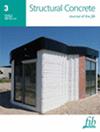A study on the sulfate erosion deterioration law and damage model of shotcrete in high geothermal tunnels
IF 3.3
3区 工程技术
Q2 CONSTRUCTION & BUILDING TECHNOLOGY
引用次数: 0
Abstract
When building a tunnel in an environment rich in high‐temperature hot water, it is particularly necessary to pay attention to the influence of sulfate ions in underground hot water on tunnel shotcrete. In order to study the sulfate erosion mechanism and mechanical properties of shotcrete in a real high‐temperature hot water environment, this study was carried out by setting the curing temperature (20, 40, 60, and 80°C), humidity (55% RH, 95% RH), and erosion age (0, 15, 30, 60, and 90 d) as the test influencing factors; a full combination of dry‐wet cycle test was carried out, and the specimens under different conditions were analyzed macroscopically and microscopically. The results show that with the increase of the number of dry‐wet cycles, the quality of shotcrete increases first and then decreases, and the mechanical properties gradually decrease. In the early stage of erosion, the erosion product is mainly ettringite, and the macroscopic damage is aggregate spalling. In the later stage of erosion, the erosion product is mainly gypsum, and the macroscopic damage is expansion damage. Compared with standard curing, a certain degree of high temperature curing has little effect on the sulfate attack resistance of shotcrete, but when the curing temperature exceeds 60°C, the concrete is seriously damaged. Finally, by constructing the damage model of sulfate attack shotcrete, the variation of compressive strength of shotcrete with age after sulfate attack under different curing conditions was successfully predicted.高地热隧道喷射混凝土硫酸盐侵蚀劣化规律及破坏模型研究
在富含高温热水的环境中建设隧道时,尤其需要注意地下热水中的硫酸根离子对隧道喷射混凝土的影响。为了研究真实高温热水环境下喷射混凝土的硫酸盐侵蚀机理和力学性能,本研究将养护温度(20、40、60、80℃)、湿度(55% RH、95% RH)、侵蚀龄期(0、15、30、60、90 d)作为试验影响因素,进行了全组合干湿循环试验,并对不同条件下的试件进行了宏观和微观分析。结果表明,随着干湿循环次数的增加,喷射混凝土的质量先上升后下降,力学性能逐渐降低。在侵蚀初期,侵蚀产物主要是乙长石,宏观破坏为骨料剥落。在侵蚀后期,侵蚀产物主要是石膏,宏观破坏为膨胀破坏。与标准养护相比,一定程度的高温养护对喷射混凝土的抗硫酸盐侵蚀性影响不大,但当养护温度超过 60°C 时,混凝土会受到严重破坏。最后,通过构建硫酸盐侵蚀喷射混凝土的破坏模型,成功预测了不同养护条件下硫酸盐侵蚀后喷射混凝土抗压强度随龄期的变化。
本文章由计算机程序翻译,如有差异,请以英文原文为准。
求助全文
约1分钟内获得全文
求助全文
来源期刊

Structural Concrete
CONSTRUCTION & BUILDING TECHNOLOGY-ENGINEERING, CIVIL
CiteScore
5.60
自引率
15.60%
发文量
284
审稿时长
3 months
期刊介绍:
Structural Concrete, the official journal of the fib, provides conceptual and procedural guidance in the field of concrete construction, and features peer-reviewed papers, keynote research and industry news covering all aspects of the design, construction, performance in service and demolition of concrete structures.
Main topics:
design, construction, performance in service, conservation (assessment, maintenance, strengthening) and demolition of concrete structures
research about the behaviour of concrete structures
development of design methods
fib Model Code
sustainability of concrete structures.
 求助内容:
求助内容: 应助结果提醒方式:
应助结果提醒方式:


